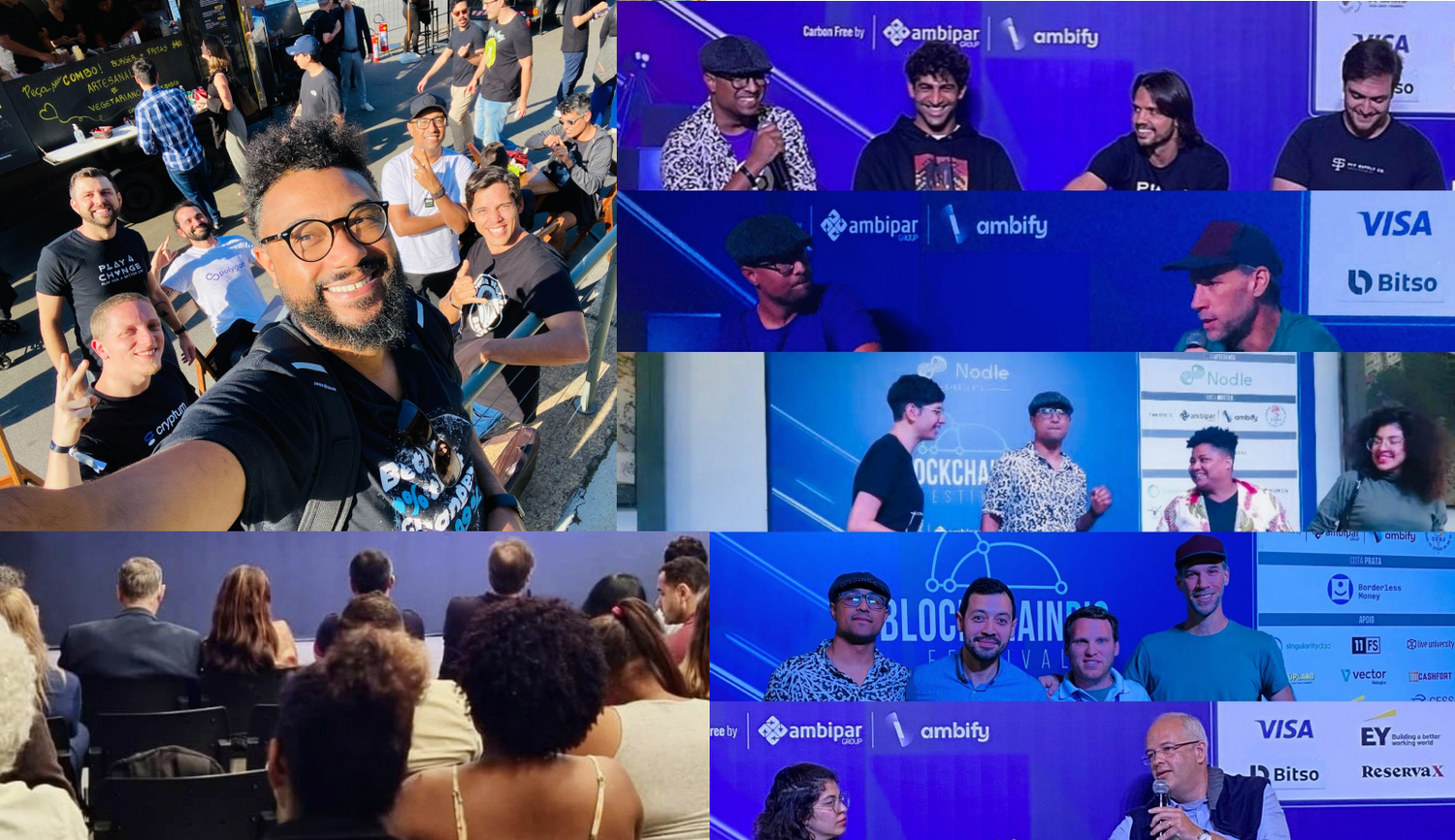The Brazilian Ecosystem of Regenerative Finance PT I
By perceiving themselves as an ecosystem, Brazilian projects are starting to coordinate talent, resources, and challenges at a national level to exponentially increase the vitality of Regenerative Finance in the country.

Regenerative Finance (ReFi) is a decentralized global movement that uses blockchain technology and web3 concepts to address the climate emergency. Brazil is worldly known for its abundance of natural resources and the challenges of protecting it, hence the fact that this specific ecosystem has grown so fast here.
The Community
The Brazilian ReFi ecosystem stands out worldwide with its growth rate and the diversity of its components.
From large companies like MOSS creating solutions to preserve the Amazon rainforest, to initiatives like AgroforestDAO that aim to accelerate the adoption of Agroforestry practices by small producers, passing through the Rio Crypto Hub that links education about DeFi with social impact.
The reason is simple: we are home to enormous biodiversity, which is under recurrent threats from both internal and external sources. We are also home to intense innovation activity, particularly in the FinTech sector.

In the second part of this article, we will present the Brazilian ReFi initiatives. Here we will talk about the moments when this ecosystem came together, and the position of ReFi Spring in this process.
The biggest meeting was certainly on the impact stage of the Blockchain In Rio event in the first days of September, the stage (called ReFi Summit) had fifteen panels on social and environmental impact.
In the first part of the day, topics such as the presence of women in Web3, Black Money, Bitcoin Mining, the Carbon Market, the future of education, and waste management were discussed.

The relaxed tone of the discussions both among the speakers and with the audience was not a coincidence, but a result of the fact that there were not only specialists in their fields but also individuals who already cooperate in several projects related to both ReFi and Social Impact in general.
This proximity meant that, instead of isolated discussions, there was a continuous dialogue distributed in different sections where the participants were interspersed between the stage and the audience.
In the afternoon, discussions shifted to financial instruments, forests, Games, and Impact-driven DAOs. The final panel was a workshop on how to build regenerative communities, where I shared the stage with Diogo J. from AgroForestDAO.
The most striking aspect of the discussions in this second part was the enormous diversity of experiences and narratives. The panels were held with the participation of activists, entrepreneurs, investors, and intellectuals, who had complete freedom to expose their positions.
It's worth mentioning that considering the context of a polarized country with little to no space for sharing ideas, the ReFi Summit was an oasis of civility, innovation, and cooperation. In Portuguese, Spanish, and “Portunhol”.
However, the day before the event Blockchain In Rio gifted us with this immersion into the ecosystem, a big part of the speakers and the audience who were on the ReFi Summit stage came together in one of the Rio Crypto Hub.
With the support of ReFi Spring, the event featured a series of lectures on ReFi and Chainlink oracles.

It is interesting to note that Rio Crypto Hub had one edition on the day before the start of Blockchain in Rio and another one right after it.
Right after the last day of Blockchain In Rio, representatives from ReFi Spring, Play4Change, Impact Plus, Chainlink, and SandBox left for the beautiful city of Seropédica to exchange an idea about Blockchain, Oracles and ReFi with students from the Federal Rural University of Rio de Janeiro in another edition of the Rio Crypto Hub.

The reality of the Brazilian ecosystem is one of uninterrupted work for survival. And the fact that all these events took place in such a short time is a good demonstration of this effort.
The sequence of the events and gatherings in Rio de Janeiro and Minas Gerais can be considered as the first steps of a road that led to the consolidation of a common narrative in the Brazilian ReFi ecosystem. Let's dive into it.
The Meaning
This Brazilian narrative consolidated in the events mentioned above refers to two basic elements: Syncretism and Ginga (as innovation).
Syncretism, the combining of diverse beliefs and schools of thought, is a hallmark of our country, and this ecosystem reflects that in a way that the rest of the innovation industry could only dream of. This unique diversity comes from both external and internal factors, including the relevance of political agendas related to inequality or climate justice.
The native projects of the Brazilian ReFi ecosystem arise with this demand for diversity, which is also an advantage as it offers access to a wide range of perspectives on topics like how to properly approach a specific social group in order to have cooperation.
One of the most explicit manifestations of this syncretism could be observed at the Primavera Regenerativa event. In this specific event, the participants organized themselves into three conversation circles where experts, newbies, skeptics, and curious people took turns contributing to the most diverse range of topics related to the intercession between regeneration, blockchain, and sacred memory.

Innovation, or ginga, relates to the fact that Brazilian Web3 entrepreneurs (we call them ‘Builders’) are used to reacting to obstacles in the most creative and unexpected ways.
This type of innovation is easily perceived in the way our Builders overcome institutional insecurity (like the lack of legal framework) and lack of resources to offer the world some of the most interesting solutions in ReFi.
Whatever the reason, the fact is that unlike our colleagues in the global north, here we are used to delivering results with very little support. The space for mistakes is small.
These two characteristics, together with a desire to open doors and build bridges, make builders anxious yet hopeful about how Blockchain can be used to address social and environmental challenges in Brazil.
The Connection
ReFi Spring, in this context, serves the humble purpose of accelerating the emergence of new micro-ecosystems by enabling events to reach new audiences inside and outside the Web3 ecosystem.
The support from ReFi Spring takes place through marketing, framework, networking, an organizer toolkit for ReFi events, content, and funds to bootstrap the events.
Except for the Blockchain In Rio event, all the other events mentioned in this article had direct support from ReFi Spring. The presence of ReFi Spring in Blockchain In Rio refers to the content delivered in six different stages, this was possible due to the diligent work of the Divas from Impacta.Finance: Rafaela Romano and Paula Palermo.
If the three editions of the Rio Crypto Hub are good examples of how a micro-ecosystem is built around the topic of ReFi, the Regenere-se event organized by Muda (also in Rio de Janeiro) was the perfect case for presenting the topic of ReFi to a new audience.
There, an audience composed of members of religions of African origin exchanged experiences and were introduced to Regenerative Finance, ReFi Spring, and the purpose of the Climate Collective.

The presence of members from Afro-Brazilian religions and the encounter with the topic of Web3 is a new thing for the ecosystem, a happy novelty organized by the Muda team together with Luísa from Studio Krya and Cambiatus.
Rio de Janeiro is a metropolis, and even though it is a geographically small city, these aforementioned events took place in profoundly different realities. The Rio Crypto Hub usually happens in urban areas with a very techie audience, and the Regenere-se happened within a sacred place for the afro-Brazilian religion Candomblé.
If Web3's biggest challenge is to achieve mass adoption, one of the priorities in the ReFi ecosystem is the onboarding of those who work directly with the land. The first step towards this challenge was the Primavera Regenerativa event organized by Diogo Jorge from AgroForestDAO in Lima Duarte (interior of Minas Gerais).

The event focused on small farmers and school-age youth in the Lima Duarte region (Minas Gerais), and took place on November 19th. It was a moment of integration and discussion about the possibilities of the ReFi ecosystem for the region.
On the 19th of November, another pioneering event, built in a partnership between BanklessBR, Chainlink, NFTFY, Zapper, and ReFi Spring, was Descentraliza-BH.
This was the first Web3 event in the city of Belo Horizonte to address ReFi. Direct mining effects have damaged Minas Gerais and the city of Belo Horizonte for decades, and the topic of ReFi is of particular importance for the region. Minas Gerais was also the Brazilian state where two (1, 2) of the biggest environmental crimes in history took place, making the demand for regenerative solutions extremely urgent.

DescentralizaBH was also important in presenting the topic of Regenerative Finance to the municipal authorities of the neighboring city (Nova Lima), in the person of Italo L. Salvador, manager of the Rego dos Carrapatos Ecological Park in Nova Lima.
Last but not least, Brazil was the place of a pioneering experience: A hackathon to tokenize all real estate properties of the Brazilian State. It was organized through a partnership between the Celo Foundation and the Brazilian public company SERPRO (Federal Service of Data Management).
The team's challenge was coming up with the best ideas to bring more than U$400bi worth of assets on-chain. This was a singular event in the history of the ReFi ecosystem as a whole, and we can be grateful for the efforts of the Celo team in Brazil (especially Mila Rioja and Rafael) and the employees of SERPRO.

This was a singular event in the history of the ReFi ecosystem as a whole and we can be grateful for the efforts of the Celo team in Brazil (especially Mila Rioja and Rafael) and the employees of SERPRO.
The Conclusion
We cannot say that the journey of events above describes all the greatness of the Brazilian ReFi ecosystem, it describes a roadmap of encounters and re-encounters that made people perceive themselves as part of an ecosystem.
By perceiving themselves as an ecosystem, Brazilian projects are starting to coordinate talent, resources, and challenges at a national level to increase the vitality of Regenerative Finance in the country exponentially.
In the next part of this article, we will talk about the initiatives and projects of our ecosystem and find out what's in the mind of the founders and CEOs of these initiatives.
If Celo's proximity to Brazil and Moss’ importance to the world have already made our country stand out in the global ReFi ecosystem, the creation of an alliance between communities that recognize themselves through the events mentioned here has the potential to take Brazil to a new level of collective leadership in the global ReFi ecosystem.
